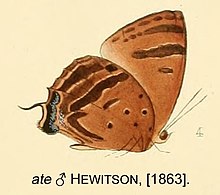| Arhopala ate | |
|---|---|

| |
| Arhopala ate from original description | |
|
Scientific classification
| |
| Domain: | Eukaryota |
| Kingdom: | Animalia |
| Phylum: | Arthropoda |
| Class: | Insecta |
| Order: | Lepidoptera |
| Family: | Lycaenidae |
| Genus: | Arhopala |
| Species: | A. ate
|
| Binomial name | |
| Arhopala ate | |
Arhopala ate is a butterfly in the family Lycaenidae. It was described by William Chapman Hewitson in 1863. It is found in the Australasian realm. [2] [3]

Description
Male above violettish-blue, but covered with a dark shadow and therefore not brightly glaring. Beneath the cross-bands are very straight and, like the scanty small proximal spots, surrounded with a light colour. [4]
Subspecies
- A. a. ate Ambon, Serang
- A. a. aruana (Evans, 1957) Aru
- A. a. jobina (Evans, 1957) Jobi, Biak, Noemfoor, New Guinea
References
- ^ Hewitson, W.C. 1863–1878. Illustrations of diurnal Lepidoptera, Lycaenidae. London, van Vorst, x + 229 pp, 107 pls.
- ^ D'Abrera, B. 1977. Butterflies of the Australian Region, edn 2. 415 pp. Lansdowne, Melbourne.
- ^ Seitz, A., 1912-1927. Die Indo-Australien Tagfalter Grossschmetterlinge Erde 9
-
^ Seitz , A. Band 9: Abt. 2, Die exotischen Großschmetterlinge, Die indo-australischen Tagfalter, 1927, 1197 Seiten 177 Tafeln
 This article incorporates text from this source, which is in the
public domain.
This article incorporates text from this source, which is in the
public domain.
External links
- Arhopala Boisduval, 1832 at Markku Savela's Lepidoptera and Some Other Life Forms. Retrieved June 3, 2017.
| Arhopala ate | |
|---|---|

| |
| Arhopala ate from original description | |
|
Scientific classification
| |
| Domain: | Eukaryota |
| Kingdom: | Animalia |
| Phylum: | Arthropoda |
| Class: | Insecta |
| Order: | Lepidoptera |
| Family: | Lycaenidae |
| Genus: | Arhopala |
| Species: | A. ate
|
| Binomial name | |
| Arhopala ate | |
Arhopala ate is a butterfly in the family Lycaenidae. It was described by William Chapman Hewitson in 1863. It is found in the Australasian realm. [2] [3]

Description
Male above violettish-blue, but covered with a dark shadow and therefore not brightly glaring. Beneath the cross-bands are very straight and, like the scanty small proximal spots, surrounded with a light colour. [4]
Subspecies
- A. a. ate Ambon, Serang
- A. a. aruana (Evans, 1957) Aru
- A. a. jobina (Evans, 1957) Jobi, Biak, Noemfoor, New Guinea
References
- ^ Hewitson, W.C. 1863–1878. Illustrations of diurnal Lepidoptera, Lycaenidae. London, van Vorst, x + 229 pp, 107 pls.
- ^ D'Abrera, B. 1977. Butterflies of the Australian Region, edn 2. 415 pp. Lansdowne, Melbourne.
- ^ Seitz, A., 1912-1927. Die Indo-Australien Tagfalter Grossschmetterlinge Erde 9
-
^ Seitz , A. Band 9: Abt. 2, Die exotischen Großschmetterlinge, Die indo-australischen Tagfalter, 1927, 1197 Seiten 177 Tafeln
 This article incorporates text from this source, which is in the
public domain.
This article incorporates text from this source, which is in the
public domain.
External links
- Arhopala Boisduval, 1832 at Markku Savela's Lepidoptera and Some Other Life Forms. Retrieved June 3, 2017.